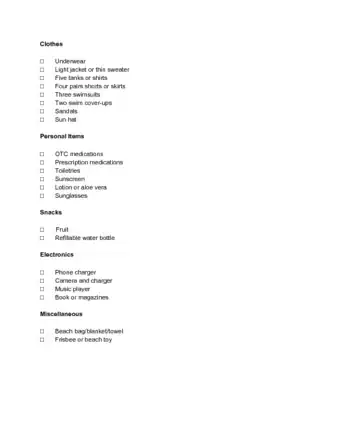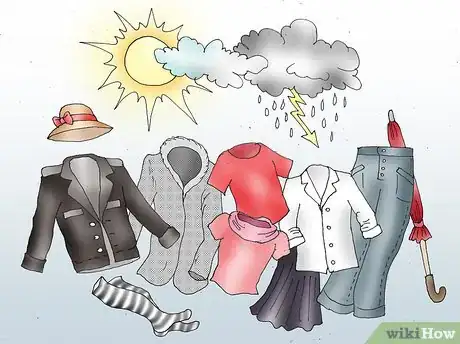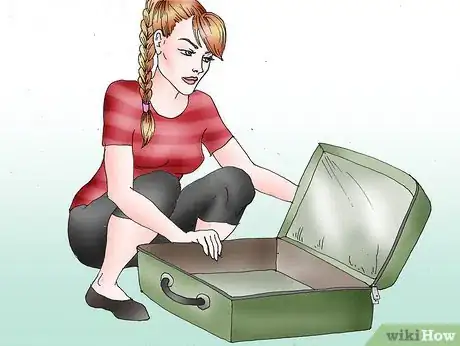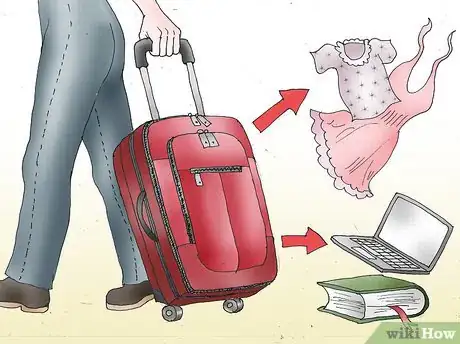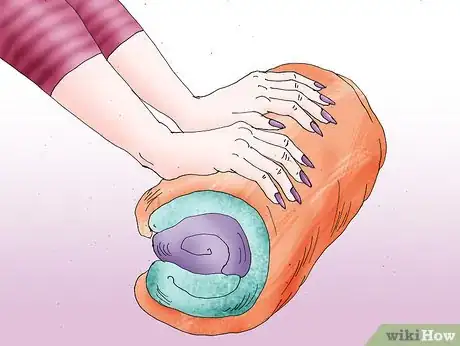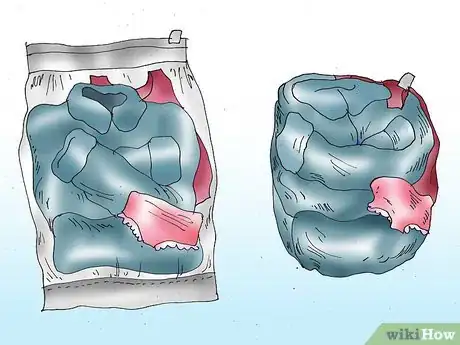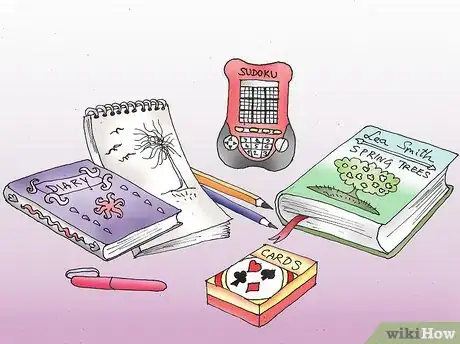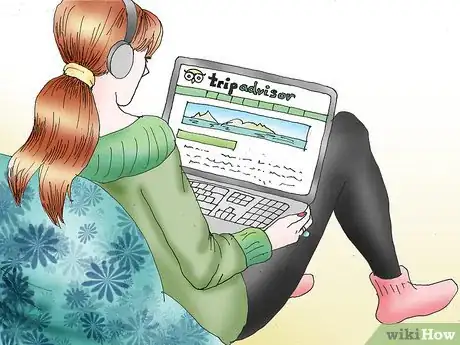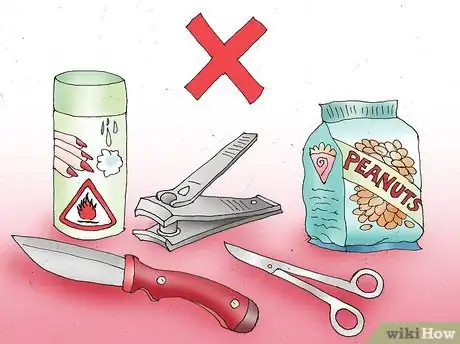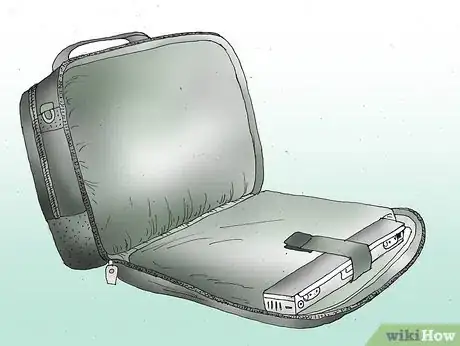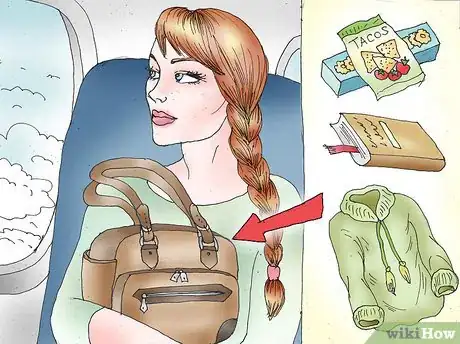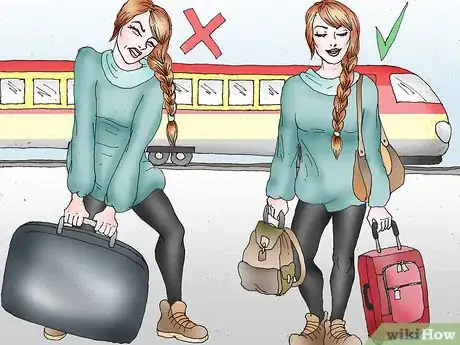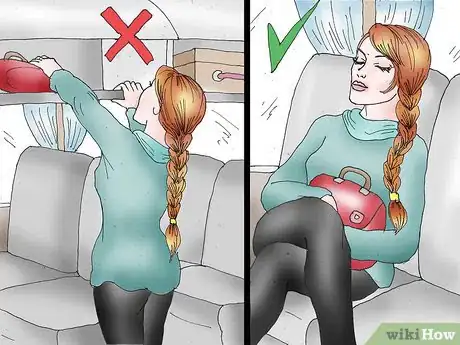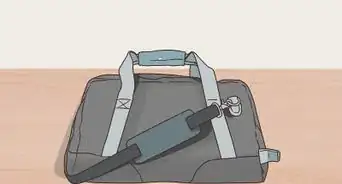This article was co-authored by Angela Rice. Angela Rice is a Luxury Travel Specialist and Co-Founder of Boutique Travel Advisors, a luxury travel advising business in Phoenix, Arizona. Angela specializes in consulting and curating highly customized and unique travel itineraries for clients seeking luxury, group, and multi-generational family travel. Angela studied at Arizona State University and The University of Iowa Tippie College of Business. She has prior consulting experience in accounting and business, which helps her run her business behind the scenes. Angela has been featured in The Washington Post, Reader's Digest, Travel Weekly, USA Today, Travel Market Report, Phoenix Magazine, and MSN. She is also a frequent guest on WBBM News Radio 105.9 FM's Travel Tuesday show.
There are 10 references cited in this article, which can be found at the bottom of the page.
wikiHow marks an article as reader-approved once it receives enough positive feedback. This article received 21 testimonials and 87% of readers who voted found it helpful, earning it our reader-approved status.
This article has been viewed 1,450,530 times.
How you pack plays a big role in the outcome of your trip -- if you've ever arrived at your destination only to find your suitcase splattered with the remains of a toothpaste explosion, you know this to be true! To pack for a trip, you have to organize everything you'll need while you're away and pack it all into your suitcase in a manner that reduces space while still protecting your stuff from leaks or other damage. There are also a few specific pointers to keep in mind for anyone traveling by plane or train.
Steps
Sample Packing Checklist
Packing Your Things
-
1Make a checklist of every item you plan to take on your trip. This will include clothing, shoes, toiletries, and paperwork and possibly also maps, guidebooks, reading material, and hotel or rental car information. This checklist will also help you when packing for the trip back home as you will have a list of everything that you brought with you.[1]
- Commonly forgotten items include toothbrush/toothpaste, socks, sunglasses, sunscreen, hat, pajamas, razors, and deodorant.[2]
- Never underestimate how quickly your space will fill up. Will you really need five pairs of shoes for three nights? And four coats? Consider the weather and what kinds of activities you will be doing. You might want to visit www.weatherchannel.com to check out how the weather will be at your destination.
-
2Plan your outfits ahead of time to avoid over-packing.[3] If you have a decent sense of what the weather will be like, you can be very precise. If not, bring versatile items (ex. a cardigan or light jacket that goes with several of your tops, some three-quarter-sleeve shirts, jeans that look good rolled up at the bottoms) that will allow you to adapt to changing conditions. Pack for the season, and as much as possible, bring items you can get away with re-wearing. Layering is a good way to not only disguise re-worn items but also deal with changing weather.
- Stretch your travel wardrobe by color-matching. If you make sure every piece of clothing you pack works with many other pieces, you can create a host of mix-and-match possibilities.
- Bring empty plastic bags for dirty items. If you won’t have an opportunity to wash your clothes, tucking them away in a separate bag will keep you from having to mingle the clean with the dirty or sort through your stuff every time you want to change.
Advertisement -
3Buy travel-size containers for your toiletries, regardless of the length of your trip. This includes your toothbrush, toothpaste, deodorant, etc. Unless you will be in a remote location for weeks, you can always drop into a local shop to restock your supply of soap and toothpaste. If you will be flying, there might also be restrictions on the amount of liquid or gel you can bring on the plane, meaning you may find yourself forced to choose between shampoo and toothpaste while going through airport security. Go to the airline's website to check out the guidelines.
- Put all your toiletries in a secure bag. You definitely do not want an explosion or a leak in your luggage! Oh, and again, these should be in travel sizes.
- If you will be staying at a hotel after your arrival, you can completely skip the shampoo and conditioner and simply use what the hotel provides. (You can buy other necessities at the destination such as toothpaste.)
-
4If you will be going through customs, check your luggage prior to packing. Ensure that it is completely empty (especially if the luggage is not yours), because as soon as you're in security check, no one is responsible for its contents except you. Usually, suitcases have hidden zippers along the center or side. Open these and give it a good once-over. It is better to be safe than sorry.
- If you will be crossing borders, consider using tamper-evident products to seal your case so you can check if your luggage arrives without being breached before you go on to clear customs.
-
5Place heavy items at the bottom of your bag, especially if it is an upright model. Struggling with a rolling luggage that twists and flips in every gentle turn and falls over when you let it go is no way to move around.[4]
- As you pack your luggage, check items off your list. Be thorough; you don’t want to have to dismantle your entire bag in a panic to find out whether or not you’ve taken care of something.
-
6Pack clothing using the time-honored "roll" technique. Lay two or three items on top of one another, smooth to flatten, and roll them up like you would a sleeping bag to save space and prevent wrinkles.[5] For added wrinkle insurance, place a sheet of heavy tissue or packing paper between items of clothing before rolling. Don't worry about wrinkle-prone garments; most hotel/motel/inn rooms have an iron and board in the closet for your needs, not to mention a hotel laundry service.
-
7Pack sweaters, jackets, and underwear in reusable compression bags, which can create up to 75% more space in your luggage. These lock in odors, so they also work for storing dirty laundry. Compression bags work very well. Ziploc sells these. What you have to do is place the item inside, close the bag, and put the included air pump over a little one-way hole. Suck out the air with the pump. It's that easy.[6]
-
8Place breakable items, like jewelry or glass, wrapped in socks and tucked into shoes inside your luggage. This ensures ultimate safety.
-
9Buy wide clip rings. Available at major supermarkets like Target or Walmart, these look like shower curtain rings, and can be opened and then clipped onto something to connect it. Clip important things like the passport baggie onto your handbag or carry-on and clip that to your suitcase. Big bulky bags that you must let go of while tending to other concerns are an obvious target for thieves. Keep paperwork, identification, money, and expensive items slung over your shoulder or even hidden on your body (you can buy under-clothing pouches for slim items) depending on the safety of the location. However, don’t hide anything you will need immediately.
-
10Bring snacks in case you get hungry. Bring light snacks for quick trips or places where you can purchase meals and heartier ones for long bus/plane/train/car rides. If you have allergies or conditions that call for certain foods (e.g. gluten-free or nut-free) and won’t have many options while traveling (planes that offer meals usually cater to this), bring more filling snacks.
-
11Bring entertainment in case you get bored. Diaries (and pens), travel-size games, decks of cards, books, and mobile devices are huge boredom-killers during long rides.
-
12Remember that trips are meant for fun and rest, not stress! Don't fret too much over organizing and planning. If it gets too stressful for you, have a traveling agency plan your voyage. Sites like tripadvisor.com or seatguru.com can help you find reviews of places, hotels, restaurants, and airlines as well as good seats and hot deals.
Packing for a Plane Ride
-
1Know which items not to bring on a plane. This applies to safety, size, weight, and even food, as there are restrictions on all of these.[7]
- Safety restrictions vary between countries but include obvious safety hazards (knives in your carry-on, flammable liquids in any of your luggage), not-so-obvious hazards (nail clippers or files in your carry-on), and a few seemingly inexplicable items (an unopened bottle of water on US flights – unless you purchased it after going through security).
- Weight and size restrictions depend on the airline, so check their website ahead of time for more information. Most medium duffel bags and hand luggage marketed as carry-on will be accepted into the cabin.
- Avoid bringing peanuts on planes. These can cause allergic reactions in other passengers.[8]
- If crossing international borders, don’t bring agricultural items (fruits, vegetables, seeds), meats, or dairy products. Though you may be able to get away with it in some countries, many regulate these items to reduce the spread of nonnative species and disease.
-
2Separate liquids from the rest of your carry-on. Liquids should be easily accessible so that you can remove them for inspection while going through security. In the US, there are very specific liquid and gel allowances:[9]
- You are allowed to bring a maximum of 3.4 ounces of a liquid/gel per container (not total). For example, a 2-ounce bottle of shampoo, a 2-ounce bottle of toothpaste, and a 3.4-ounce bottle of face wash would be okay.
- All individual containers of liquid must be placed together inside a resealable 1-quart bag (provided for you if necessary as you move through the security line). Before you and your luggage go through the scanners, you will have to place the bag of liquids by itself on the luggage conveyor belt so that it can be inspected if necessary.
- To circumvent the hassle of packing and storing liquids separately, bring solid toiletries (ex. solid deodorant, powder concealer, etc.). You can also put liquids in your carry-on bag.
- Liquid allowances don’t usually apply to prescription medication (provided that you have documentation with you to verify), infant formula, breast milk, or the like. Just be sure to store these separately from your other liquids and inform an agent that you have them.
-
3Avoid checking in luggage if possible. Many airlines pad their bank accounts by charging passengers for check-in luggage. Even if you don’t mind the extra expense, waiting for check-in luggage to be processed and redistributed after arrival can add another half hour or more to your airport experience – and occasionally, bags that don’t make the flight must be sent to you at a much later date. If you are traveling with kids, make sure each one carries the maximum amount of luggage allowed (if possible) so that, as a group, you can bring more items into the cabin. Wear your heaviest clothing (such as jeans, running shoes/tennis shoes, sweatshirt) while traveling to save on space. Consider replacing your jeans with light-weight travel pants which take less space and dry quickly.
-
4Consider getting a TSA-approved laptop bag. If you are flying in or through the US and your laptop is inside your bag together with other items, you will be asked to remove it before your things are X-rayed, which can slow down the line and create a mess if not properly organized. If you’re still luggage-hunting, you might want to get a bag designed to avoid this process (usually consisting of a laptop flap that folds away from the rest of the bag so that the laptop can be X-rayed by itself without technically being removed).
-
5Keep your most important items in your smallest bag. Most airlines allow one small and one medium piece of carry-on so that people are still able to bring things, like purses and diaper bags. Since you will most likely be stowing the larger of the two bags in the overhead bin, avoid putting things you will want during the flight (ex. a sweater, book, or snack) up there or you will have to stand in the aisle and dig through it mid-flight.
Packing for a Train Ride
-
1Distribute heavy items evenly between bags. Most trains have huge luggage allowances, making them a great alternative to planes in some situations. Like on planes, these items are often stored in overhead bins, but since you may be dealing with full-sized luggage instead of little bags, lifting them up and getting them back down can be tricky. Make sure you don’t have any one bag that feels like a ton of bricks or you may find yourself stuck in the aisle with shaky knees and a bag over your head asking strangers to bail you out.
-
2Keep valuables on your person. Stowing luggage in the overhead bin might make you feel so much like you’re on a plane that you decide it’s safe to put important items there, but remember that your stuff won’t be monitored by attendants and that passengers get on and off trains all the time. Carry your valuables with you at all times, especially if you plan to stretch your legs, get snacks, or nap.[10]
-
3Make sure the train offers snacks before deciding not to pack any. Most trains do (or stop at places where either vendors come aboard with food or you can quickly pop out and get some), but if you’re traveling in a country where you aren’t as familiar with the customs or train protocol, make sure you don’t find yourself on a 18-hour overnighter without a scrap of food or drink.
Community Q&A
-
QuestionHow many days before the trip should I plan and pack everything?
 Community AnswerPack about two to three days before the trip. This way, you're not worrying about packing all your stuff 30 minutes before you leave and leading up to the day you leave you might think of something you forgot to pack.
Community AnswerPack about two to three days before the trip. This way, you're not worrying about packing all your stuff 30 minutes before you leave and leading up to the day you leave you might think of something you forgot to pack. -
QuestionHow should you pack for a trip when you are going to be bringing back more than you left with?
 Community AnswerPack lightly to begin with and perhaps take clothes with you that you don't mind leaving behind (hit the thrift store) so that you can bring home new clothes and things instead. Pack an additional bag or two, or be prepared to buy those at the destination. However, bear in mind the costs of additional bags or space availability, depending on your type of transportation. It can be helpful to look up ways to make one outfit go further with simple changes of clothing, as that means you pack fewer items of clothing.
Community AnswerPack lightly to begin with and perhaps take clothes with you that you don't mind leaving behind (hit the thrift store) so that you can bring home new clothes and things instead. Pack an additional bag or two, or be prepared to buy those at the destination. However, bear in mind the costs of additional bags or space availability, depending on your type of transportation. It can be helpful to look up ways to make one outfit go further with simple changes of clothing, as that means you pack fewer items of clothing. -
QuestionWhat should I pack to keep me busy at the airport and on the plane?
 Community AnswerPack some electronics, such as a mobile phone, tablet, or laptop. You can also pack a book, a notebook, or a sketchbook. If you are traveling with other people, you could bring a deck of cards instead. Many planes also have movies that you can rent out and watch on a private screen.
Community AnswerPack some electronics, such as a mobile phone, tablet, or laptop. You can also pack a book, a notebook, or a sketchbook. If you are traveling with other people, you could bring a deck of cards instead. Many planes also have movies that you can rent out and watch on a private screen.
Warnings
- Be aware of the dangers of luggage tampering. Check your luggage prior to going through immigration to ensure its integrity.⧼thumbs_response⧽
- Be sure to pack medications and other important items in your hand carry, not your check-in baggage. If your luggage gets misrouted, you will still have them.⧼thumbs_response⧽
- In some countries, you are not allowed to bring in certain foods, and can get fined or arrested. Be sure to double-check what you're allowed to bring into the country.⧼thumbs_response⧽
- Keep in mind that the FAA's airport security measures disallow many carry-on items including straight razors, scissors, and "strike-anywhere" matches. For a complete list of both prohibited and permitted items, check out TSA's chart here.⧼thumbs_response⧽
References
- ↑ https://www.travelandleisure.com/travel-tips/packing-tips/how-to-pack-packing-list
- ↑ https://www.cheapflights.com/news/12-things-travelers-forget-and-how-to-make-do-without-them
- ↑ https://www.travelandleisure.com/travel-tips/packing-tips/packing-mistake-solutions#overpack
- ↑ https://www.nytimes.com/guides/travel/how-to-pack-a-suitcase
- ↑ https://lifehacker.com/tip-tester-the-best-way-to-pack-a-suitcase-1730049399
- ↑ https://newyork.cbslocal.com/2016/12/21/saving-space-how-to-pack-your-bulky-winter-clothing/
- ↑ https://www.tsa.gov/travel/security-screening/whatcanibring/all
- ↑ https://www.smartertravel.com/is-it-ok-to-bring-peanuts-on-a-plane/
- ↑ https://www.tsa.gov/travel/security-screening/liquids-rule
About This Article
When you pack for a trip, wrap breakable or fragile items, like jewelry or glass, in socks and tuck them into shoes inside your luggage. To avoid wrinkles, lay 2-3 items flat and roll them up like a sleeping bag. You’ll also want to secure your toiletries by putting them in a sealed bag to avoid any spills or leaking. As you pack, make sure to put any heavy items on the bottom of your bag, especially if it's an upright model, to make wheeling it around easier. To learn how to distribute heavy items evenly between 2 bags, keep reading!




